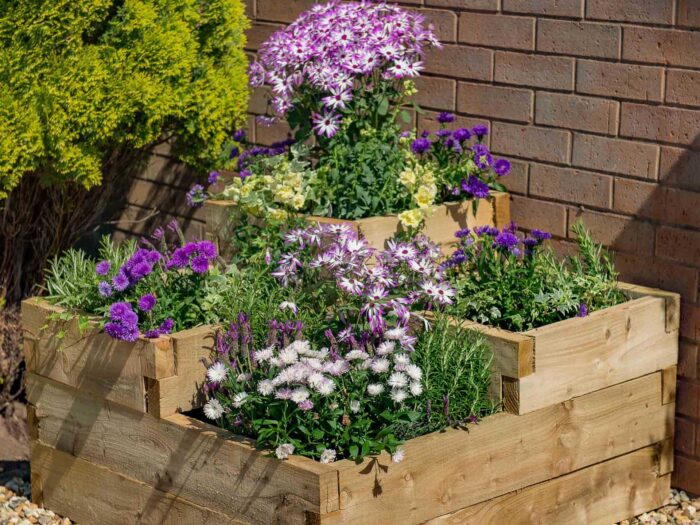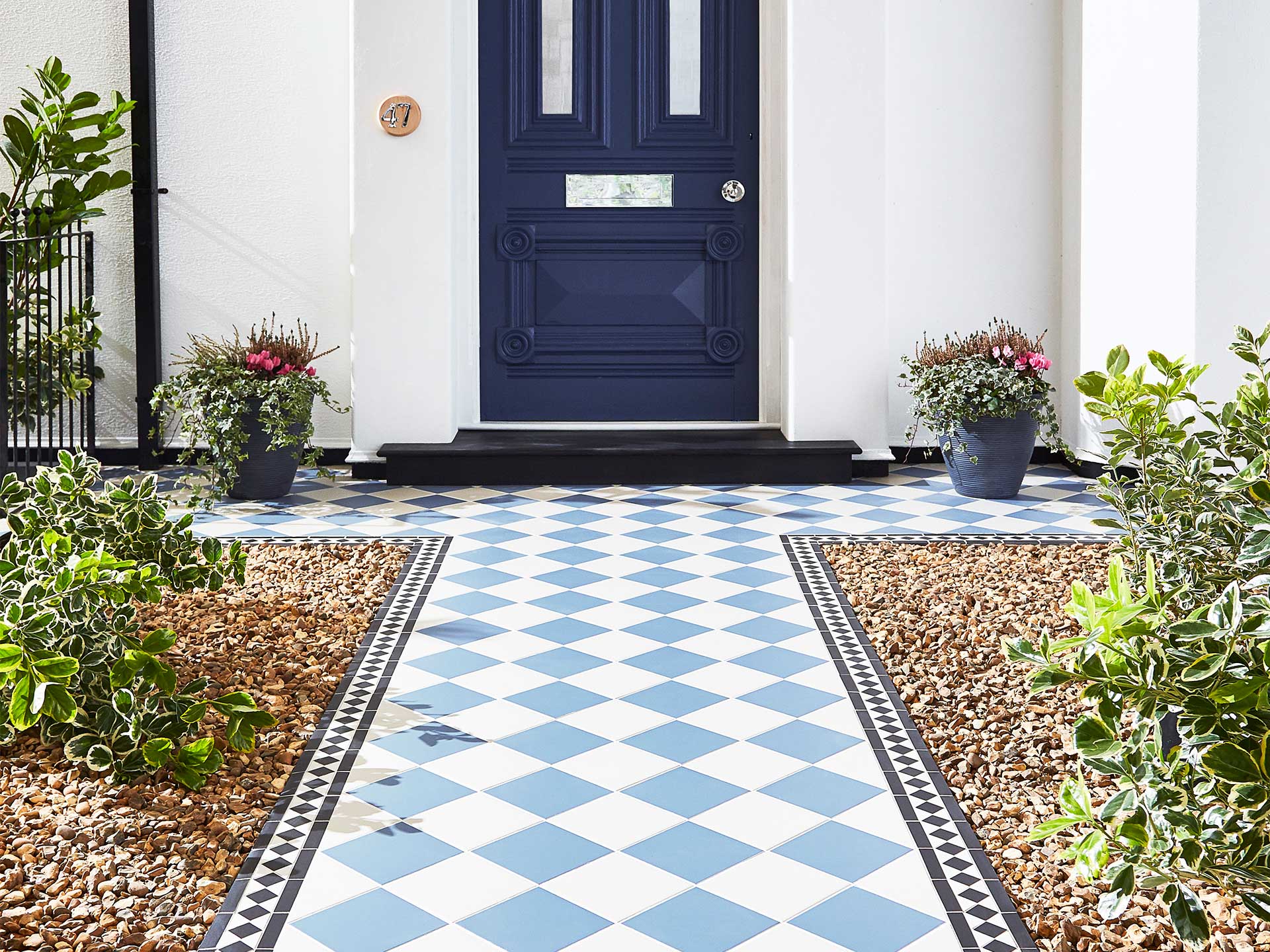
Image credit: Walls & Floors
Victorian terrace front garden ideas
Victorian terrace front gardens can be the unsung heroes in not only increasing your home’s kerb appeal and value, but also in nurturing a space of green, which however small is more important than we may realise.
The RHS has reported that “more than 4.5 million UK front gardens contain no plants at all, and a quarter of front gardens are now totally paved over”. The main reason? Our increasing reliance on owning cars and needing somewhere to park. While space is at a premium, there are so many benefits to keeping paving to a minimum and creating a showstopper front garden.
Firstly, hard surfaces absorb heat in the day and release it at night. This means the temperature around your home can increase (and in cities can contribute to the urban heat island effect). Paving and hard surfaces are not permeable and stop rainfall getting to the ground, which could contribute to flooding or subsidence.
Adding plants and flowers to your front garden can reduce the particulate and dust pollution around your home, particularly useful if you live in a built environment, and can help you breathe more easily. Hedges absorb sound and pollution and create more privacy. And you could even add plant pots for growing herbs and vegetables.
The Victorians were proud gardeners, and it was an era of creativity and experimentation in the garden. Gardens were also a status for the Victorians and a front garden, in particular, was a way to show off. Restore your Victorian terrace to its former glory with these Victorian terrace front garden ideas.
Introduce climbing plants
It’s well-known that plants and well-kept Victorian terrace front gardens can add value to a home, particularly something like a swoon-worthy wisteria on a Victorian façade, or a quintessential cottage festooned with white roses. The Victorians were especially partial to planting roses, and smelling their sweet fragrance every time you open your front door takes some beating.
Think about the positioning of your house and whether the climbing plants will get the right amount of shade or sun they need. The rambling rose is perfect for covering large walls, and flowers in late spring to early summer, plus is an easy plant to train. Clematis, honeysuckle and petiolaris (a type of climbing hydrangea) are all good plants to think about for the front of your house. Make sure you have a frame, like a trellis, for your plants to grow on, and keep them regularly pruned.
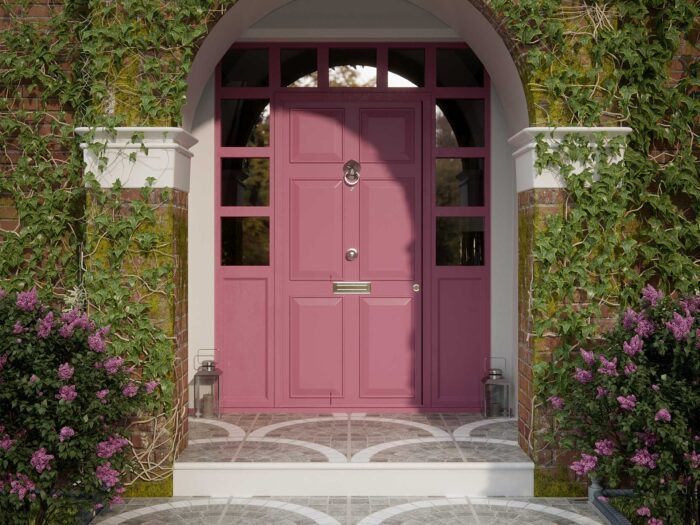
Light the way
When creating a warm, welcoming home, a well-designed lighting scheme is imperative, both indoors and outdoors. And while the back garden is likely to get more of your attention, don’t neglect the front. A perfectly lit front garden will set the scene for guests arriving and is generally much more practical if you’re arriving home in the dark.
If you have a porch, that can be a great place to hang a few lanterns, or add some soft uplighters to the wall. Alternatively, landscaping your front garden path with a candlelit-style, solar-powered walkway will offer a romantic feel. Only use your outdoor lights when you need them though, to reduce the effects of ALAN (artificial light at night) on nocturnal wildlife.
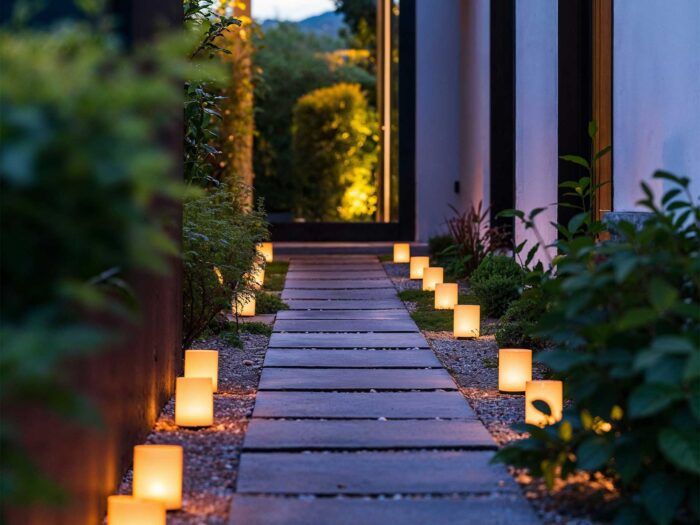
Neaten borders between edging and railings
The Victorians loved both a border and a railing. Cast iron increased in popularity in the Victorian times and it was regularly used decoratively in front of Victorian houses (they were usually elaborate and signified wealth). A cheaper riff on the Victorian railing is Agriframes‘ huge collection of traditional, elegant border edging, which is ideal for keeping your borders upright.
English Heritage has explained one of the reasons that gardening was so popular in Victorian times, as plants were becoming more widely available.
“Advances in the way plants were transported and transplanted meant that botanists were able to raise specimens imported from all over the world. From the 1830s plant diversity was also increased by experiments in creating hybrids, they say.
Bright colours filled Victorian flowerbeds with bedding plants like scented stocks, petunias, dahlias and geraniums.
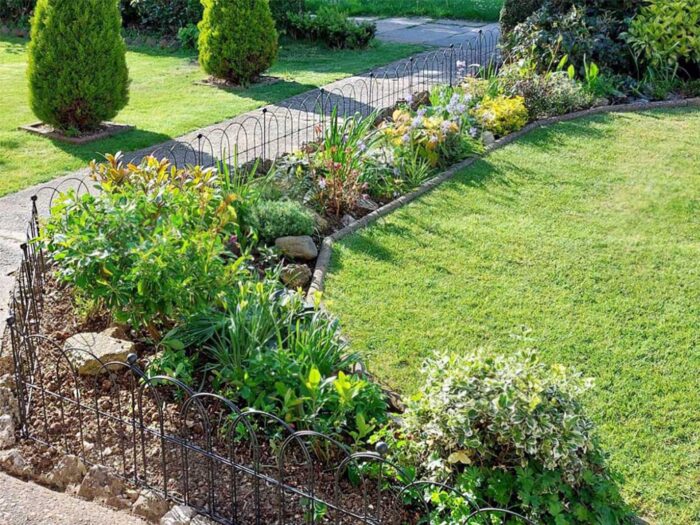
Add height and privacy with a pergola
If you lack space, a front garden idea that can add height and bring privacy, is to add a pergola. It can act as a semi-sheltered extension of your front door, and create shade or even a boot store. You can buy a pergola relatively inexpensively from B&Q and they’re simple to put up. They can bring so much colour to your garden and provide a haven for wildlife.
Climbing plants all work well on a pergola, with roses and clematis coming in as a firm favourite. If you don’t have room for a pergola, a slimmer wooden garden arch can work just as well.
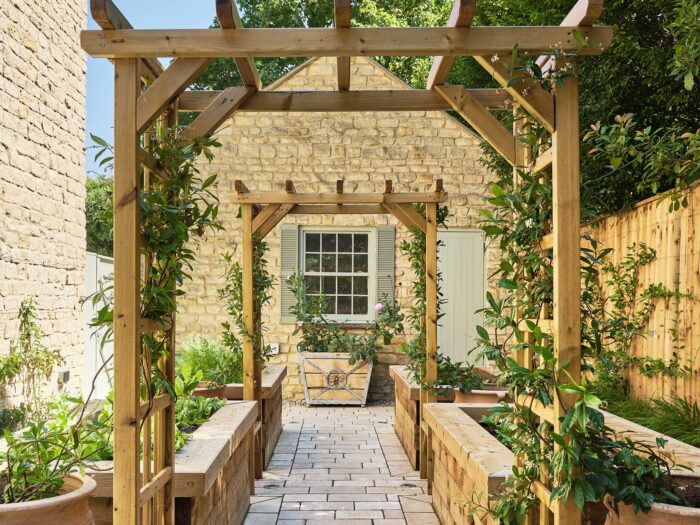
Create fragrant borders
While many Victorian gardens favoured a structured look, it was also an era of creativity, and beautiful herbaceous borders were coming into fashion. British horticulturist Gertrude Jekyll pioneered the herbaceous perennial border, and it’s no less popular today.
Perennial plants will live for more than two years and die back in the winter. Bring in plenty of colour to your borders, layer the plants by height and consider the “no-dig” method when planting. No dig is where you use organic compost instead of digging the soil, so as to preserve the soil structure. Then, of course, there are fragrant plants. Think about August lilies, bee balm, phlox, Lily-of-the-valley and coneflowers (echinacea).
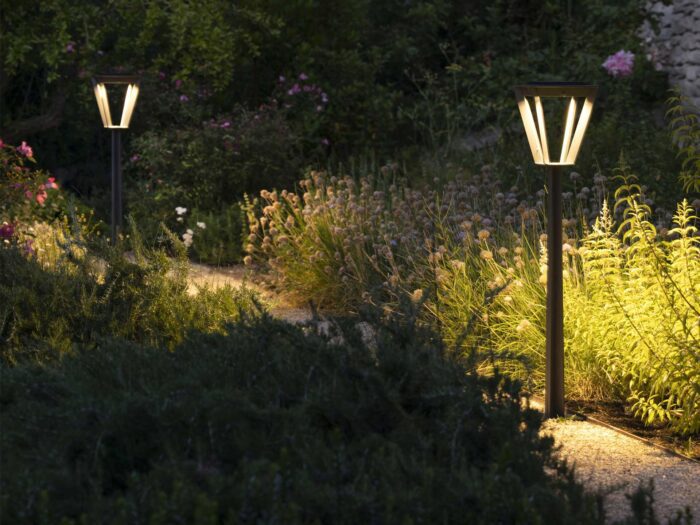
Utilise space with a wall-mounted boot rack
Front gardens can be wasted spaces, so why not make them more practical? A wall-mounted boot rack can save both space and time, as you can just grab your wellies on your way out for a walk. This wooden wall-mounted one (pictured) from the aptly named A Place for Everything, is perfect. It stores up to four pairs of wellies, so they can air dry quickly and it’s fitted with a shelf above, to protect your wellies from the rain or getting any sun damage to the rubber soles. It also acts as a handy coffee table, for a standing chat with a neighbour.
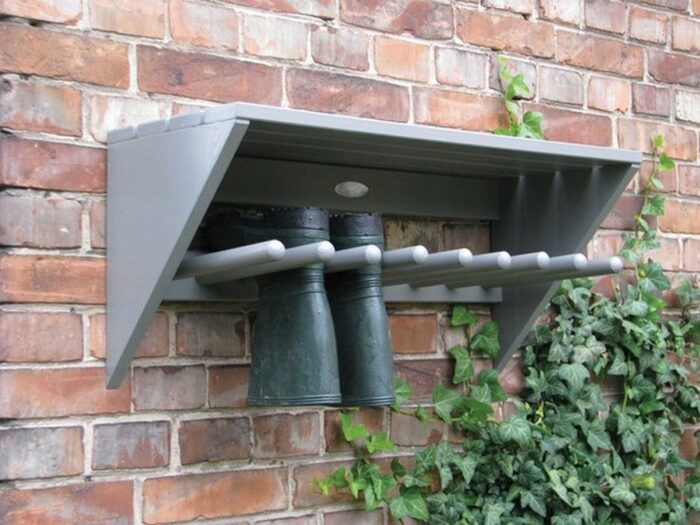
Lay traditional Victorian tiling and gravel
Geometric tiling was a mainstay of the Victorian era and the iconic look will smarten up any property. Whether yours are still in mint condition – the Victorians built things to last after all – or if you go for new or reclaimed tiles, they’ll still require a level of maintenance.
The Victorian Emporium says, “The most popular and classic choices are a 10×10 black and white, black and red or red and white chequer board pattern laid in squares or turned 45° and laid as diamonds with a border around the perimeter.”
A tiled path will likely require a concrete base. Offset this by surrounding the path with more permeable paving, like gravel, so the rain has somewhere to drain and does not cause flash flooding. Gravel is the cheapest of the non-permeable paving options and can be bought easily. Gravelrings Gravel Grids are a more sustainable way of adding gravel to your front garden pathway.
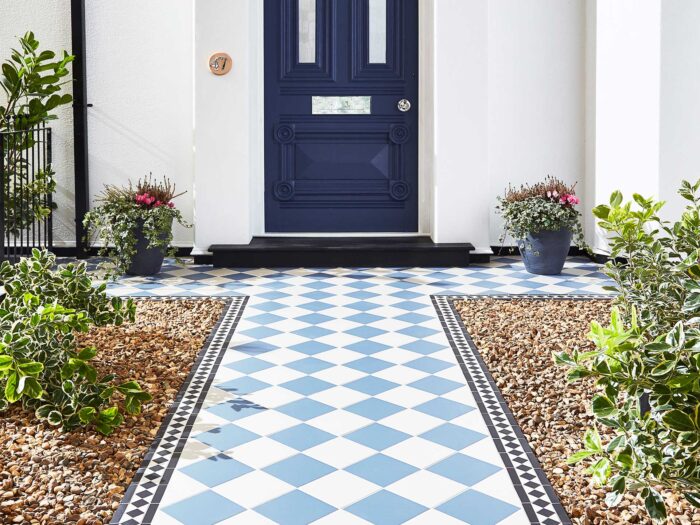
Go all green with your colour scheme
Evergreen planting and an all-green colour scheme can look beautiful against honey-hued Cotswold stone or red brick Victorian houses. Soto Gardens have a great collection of evergreens for your front garden and instead of working out what goes with what, they’ve done the hard work and you can buy their Evergreen border collection (like pictured).
Sizing runs from two to seven meters and they say it’s perfect for under windowsills, along paths and either side of your front door. Continue your planting colour scheme with your paintwork on the door, door frames and window frames (plus the garden gate if you have one).
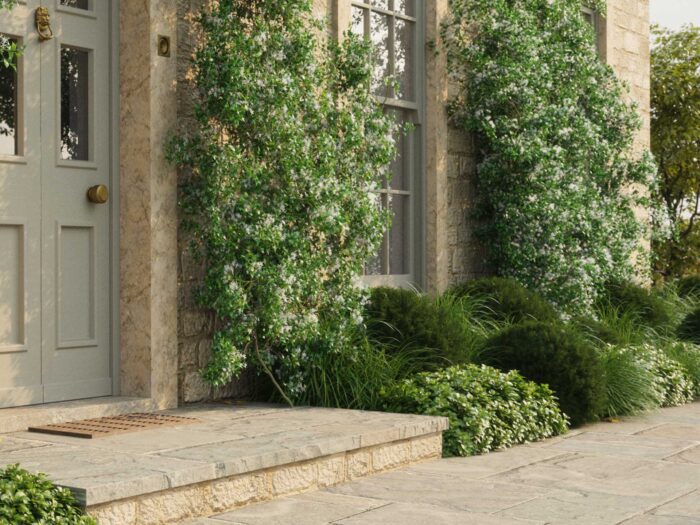
Bring in colour with stepped planters
Even if you have no Victorian terrace front garden and your front door leads out to the street, you can still bring colour and nature to your outside space. B&Q has a range of planters, including Forest’s wood raised bed kit (pictured) and their Bopha wooden planters with a liner and a trellis, which would look great either side of your front door.
You can even utilise your front garden space to grow herbs in plant tubes and hanging baskets, vegetables in easy to assemble modular veg boxes and things like salad, strawberries and tumbling tomatoes in window boxes.
